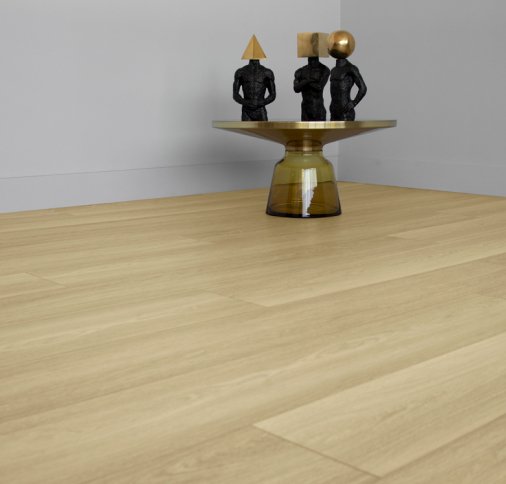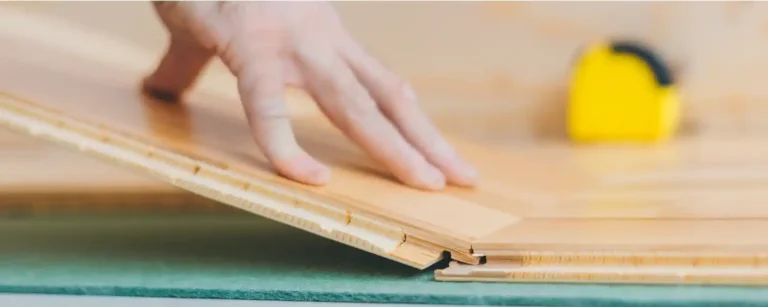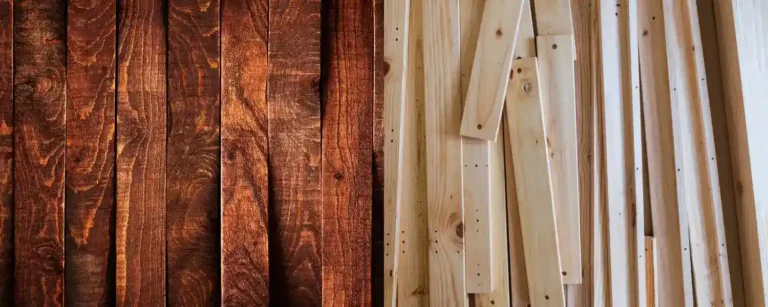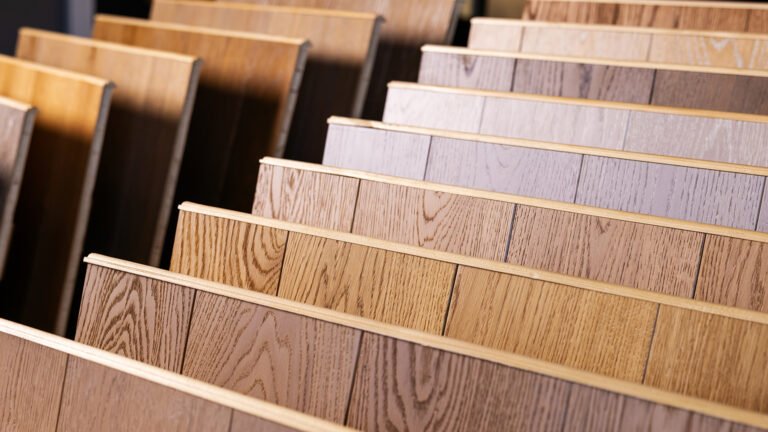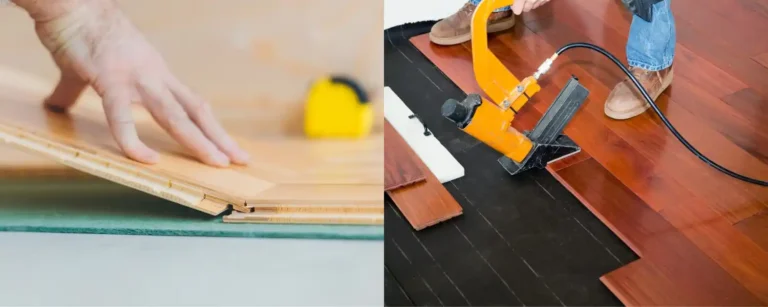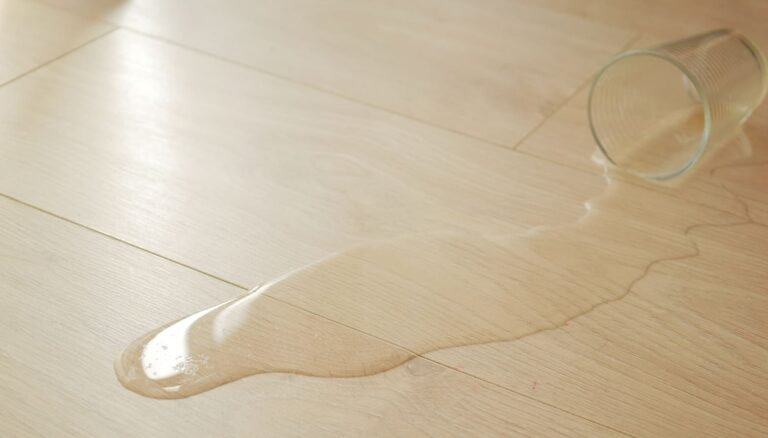How Long Does Engineered Hardwood Last?
Homeowners and builders ask, “How long does engineered hardwood last?”. They value engineered hardwood flooring for its durability, versatility, and aesthetic appeal. Unlike traditional solid hardwood made from a single piece of wood, engineered hardwood is created from multiple layers of wood veneer bonded together with adhesive.
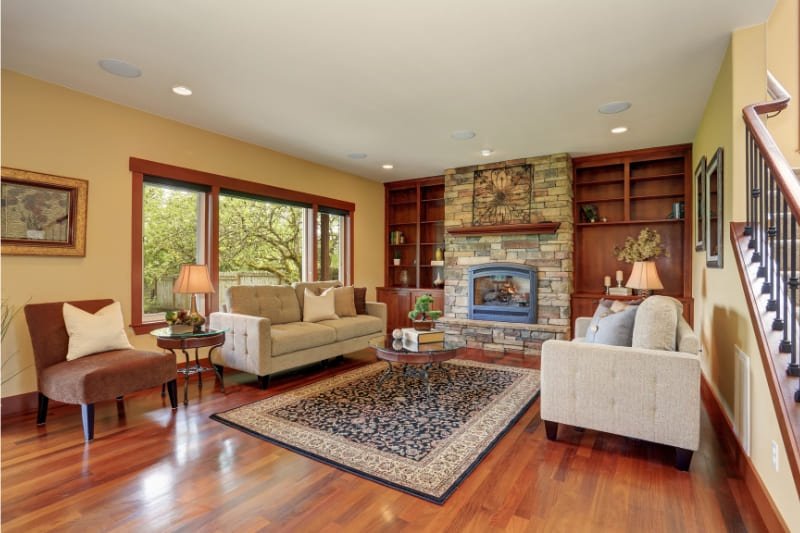
To discover the lifespan of engineered hardwood flooring, continue reading this blog.
What is Engineered Hardwood?
Engineered hardwood is an alternative to traditional hardwood. It is crafted by layering multiple wood veneers in a cross-grain arrangement, which makes it more stable and less susceptible to moisture damage than solid wood. The top layer is made of hardwood veneer, providing the desired aesthetic appeal of wood flooring. We can typically sand and refinish this wear layer to renew its appearance.
Underneath the wear layers are core layers made from plywood, HDF, or other composite materials. These core layers provide structural integrity and support the flooring, contributing to its durability and stability. Learn more about engineered hardwood flooring in our comprehensive post, “What is Engineered Hardwood Flooring?“
Factors Affecting the Longevity of Hardwood
Engineered hardwood is renowned for its durability and timeless charm, but several factors can impact its lifespan. These factors include environmental conditions, maintenance routines, and other elements that determine the longevity and overall condition of the flooring. Join us as we explore these factors in detail.
Quality of Materials
The quality of the material used in constructing engineered hardwood flooring greatly affects its longevity. The durability and lifespan of the flooring depend on the thickness and quality of the wear layers and the type of bonding adhesive used in its construction. Manufacturers produce high-quality engineered hardwood using premium wood veneers for the top wear layer and durable composite materials for the core layers, resulting in a longer lifespan than budget-friendly engineered hardwood.
Installation Process
Proper installation is important for maximizing the longevity of engineered hardwood flooring. Factors such as subfloor preparation, flooring acclimation, and appropriate installation methods (glue-down, nail-down, or floating) play a crucial role in the long-term performance of engineered hardwood. Following manufacturer guidelines and industry best practices during installation helps ensure the floor’s structural integrity.
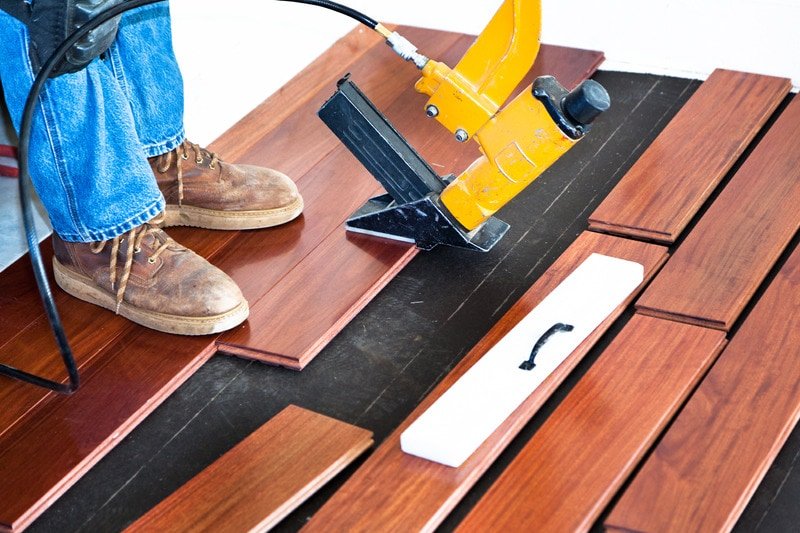
Discover the installation process in our other blog post, “Engineered Hardwood Flooring Installation Made Easy“
Maintenance and Care
Regular maintenance and proper care are key for preserving the appearance and lifespan of engineered hardwood flooring. The process includes routine cleaning to remove accumulated dirt and debris and prompt spill cleanup. It is essential to use suitable cleaning products and methods the manufacturer recommends. Moreover, to extend the lifespan of the flooring, it is important to protect it from excessive moisture, scratches, and direct sunlight.
Learn the techniques to clean engineered hardwood in our other blog, “How to Clean Engineered Hardwood Floors“
Environmental Factors
Environmental conditions, like humidity, temperature, and sunlight, can affect the condition and lifespan of flooring. Changes in humidity level can cause the flooring to expand or contract, leading to warping or cupping over time. Direct exposure to sunlight can fade the color and finish of the flooring. At the same time, extreme temperature changes can affect its stability. Maintaining stable indoor humidity levels and using window treatments to minimize sunlight exposure can help reduce these effects and increase the lifespan of engineered hardwood flooring.
Average Lifespan of Engineered Hardwood
The typical lifespan of engineered hardwood flooring ranges from 20 to 30 years or more, depending on factors such as the quality of materials, installation process, maintenance routines, and environmental conditions. Suppose you take good care of high-quality engineered hardwood floors with thicker wear layers. In that case, they can withstand more wear and tear, potentially lasting longer. However, suppose you use lower-quality materials or don’t care for your floors properly. In that case, you may end up with a shorter lifespan. Proper installation following manufacturer guidelines, industry standards, and regular maintenance can help preserve the flooring’s appearance and structure. It’s worth noting that this lifespan estimate is a general guideline, and actual results may vary depending on individual circumstances.
Signs of Wear and Tear
Engineered hardwood flooring is an excellent choice for homeowners who want to improve the appearance of their homes. However, regular use and changing environmental conditions can show signs of wear and tear. Recognizing these signs is important for preserving the beauty and duration of your floors. Let’s learn about the indicators of wear and tear of engineered hardwood flooring.
Visual Indicators
Surface scratches, dents, and discoloration are visual indicators of wear and tear on engineered hardwood flooring. These marks are often more noticeable in high-traffic areas. Furthermore, exposure to sunlight may cause fading or color change over time, which are also signs of wear and tear.
Structural Changes
Structural changes in engineered hardwood flooring refer to more significant changes in the flooring’s design. Common structural changes include warping, cupping, or buckling of the floorboards. Warping occurs when the floorboards become uneven or curved. At the same time, cupping refers to a concave shape where the board’s edge is higher than the subfloor. Moisture-related issues, such as water leaks or high humidity, often cause these structural changes.
Extending the Lifespan
While engineered hardwood is well-known for its durability, proper care and maintenance are essential to ensure its longevity. In this section, we’ll cover the various strategies and practices for extending the life of engineered hardwood flooring.
Proper Maintenance Techniques
Proper maintenance techniques are essential for expanding the lifespan of engineered hardwood flooring. To achieve this, homeowners must regularly clean the flooring using manufacturer-approved products and methods to remove dirt, debris, and spills. You must avoid harsh cleaning products and excessive water since they can damage the flooring finish. Using furniture pads, area rugs, and mats in high-traffic areas can also help prevent scratches and dents, preserving the flooring’s appearance.
Repair and Restoration Options
Over time, engineered hardwood flooring is likely to experience wear and tear. Knowing the available repair and restoration options can help homeowners address issues effectively and promptly. For minor surface scratches and dents, spot repairs using wood filler or touch-up kits can hide imperfections. However, suppose the damage of wear is more significant. In that case, seeking professional refinishing or restoration services may be necessary to sand, re-strain, and refinish the flooring. It will help restore the flooring’s original beauty and durability.
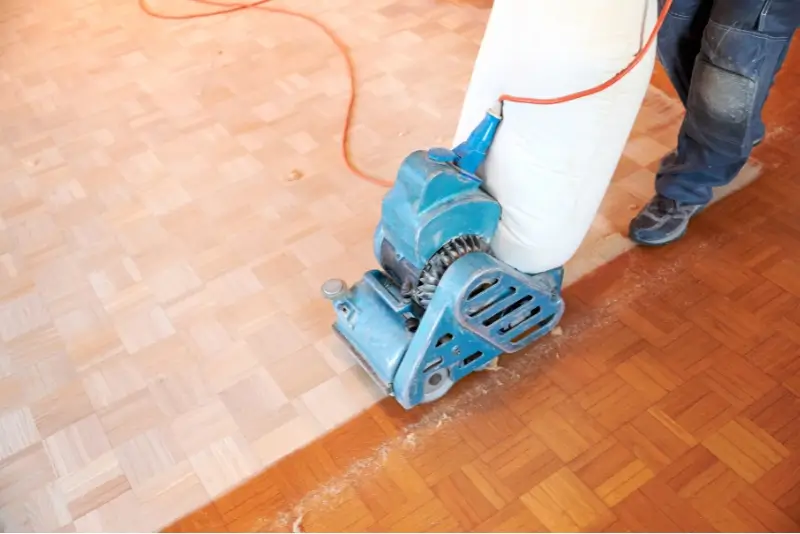
Professional Inspection and Care
Regular professional inspection and care can help identify potential issues early and prevent them from further damage. Professional flooring technicians can assess the condition of the flooring, look for signs of moisture damage or structural issues, and recommend the appropriate maintenance or repair measures.
Comparison with Other Flooring Options
Choosing flooring for a home or commercial space can be daunting, given the many options available. Engineered hardwood flooring is popular for its elegance, durability, and versatility. However, comparing this flooring with other options is essential to make an informed decision that meets your needs and preferences. So, let’s look at engineered hardwood flooring and its alternatives.
Versus Solid Hardwood
Engineered hardwood flooring has several advantages over solid hardwood. Although both options offer the timeless beauty of wood flooring, engineered hardwood is generally more resistant to moisture and temperature fluctuations because of its layered construction. This feature makes it suitable for installation in areas where solid hardwood, such as basement or concrete slabs, may not be appropriate. Additionally, engineered hardwood is usually more affordable than solid hardwood, making it a more cost-effective alternative for homeowners who want the look of hardwood without paying a higher price.
Learn the difference in our other blog, “Engineered Hardwood Vs Hardwood“
Versus Laminate and Vinyl Flooring
Regarding flooring options, engineered hardwood is better than laminated and vinyl flooring. The main reason is that engineered hardwood offers a more natural wood look and feel. At the same time, laminate and vinyl can only mimic the appearance of wood but often lack the depth and texture of real wood. Moreover, engineered hardwood is more durable and can last longer. It is also possible to sand and refinish engineered hardwood multiple times, making it a more sustainable option in the long run.
Learn the difference in our other blog, “Which Is Better: LVT Vs Engineered Hardwood?“
Cost-Benefit Analysis
Engineered hardwood may be more expensive upfront than laminate or vinyl flooring. However, it offers a better return on investment (ROI) over time due to its durability and potential for refinishing. On the other hand, solid hardwood may come with a higher price tag. It may require additional maintenance and care to preserve its appearance. Homeowners need to evaluate the pros and cons of each option based on their priorities, whether that be durability, aesthetics, affordability, or ease of maintenance, to ensure that they choose the right flooring that aligns with their preferences.
Learn more about the cost of Engineered Hardwood Flooring in our comprehensive post, “How much does Engineered Hardwood Flooring Cost?“
Elevating Spaces with Engineered Hardwood Excellence
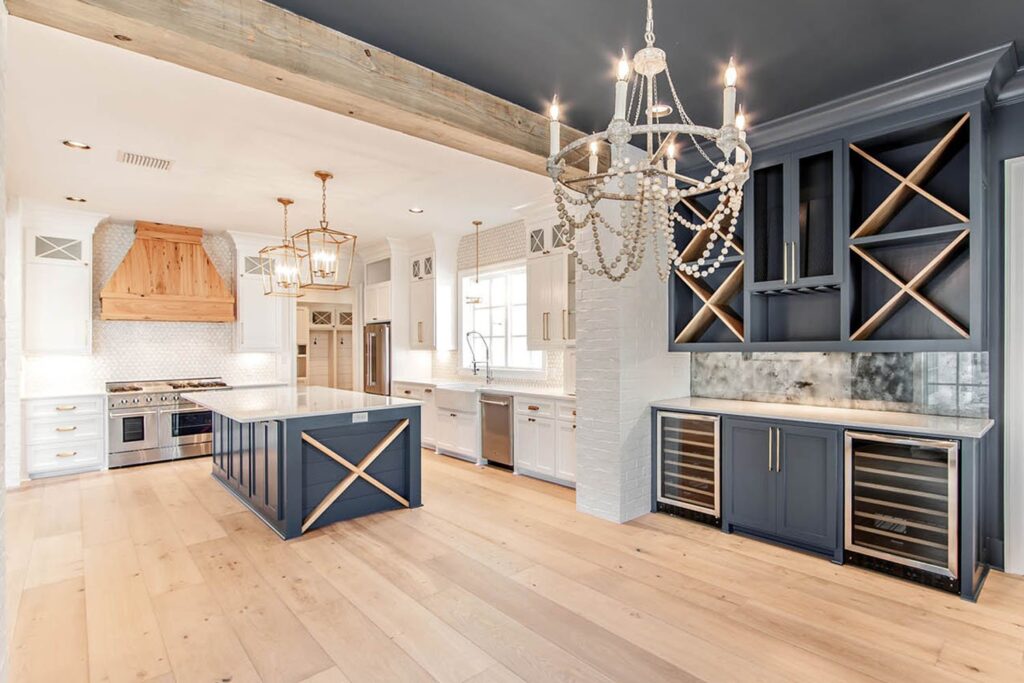
Homeowners and retailers need to understand the factors that affect the lifespan of engineered hardwood flooring. Every aspect, from the quality of materials used in construction to proper installation techniques and ongoing maintenance, plays a crucial role in determining how long engineered hardwood will last. Retailers can ensure that their customers enjoy the beauty and durability of engineered hardwood flooring for years by following recommended maintenance practices and promptly addressing signs of wear and tear.
At Villagio Wood Floors, we are committed to delivering expertly crafted engineered hardwood flooring built to last. Our flooring products are carefully crafted with precision and attention to detail, using premium materials to ensure long-lasting durability. Our collection features various styles and finishes that cater to diverse aesthetic preferences while delivering exceptional performance. Choose Villagio Wood Floors engineered hardwood for the perfect combination of timeless elegance and superior durability. It is ideal for retailers offering their customers top-quality flooring solutions.
How long does engineered hardwood last? – FAQs
Can you paint engineered wood?
Yes. You can paint engineered wood flooring. However, to ensure good adhesion, it’s essential to prepare the surface properly by sanding it lightly and cleaning it thoroughly. A high-quality primer and paint for wood surfaces will also help achieve the best results. Remember that painting engineered wood will change its appearance and affect its refinished ability.
Is thicker engineered wood better?
Generally, thicker engineered wood flooring tends to be more stable and long-lasting than thinner options. Thicker planks usually have a thicker wear layer, allowing for more sanding and refinishing. However, the overall quality of the engineered wood, including the materials used in its construction and the manufacturing process, also plays a significant role in its durability and overall performance.
Does engineered wood get darker over time?
The color of engineered wood flooring may change over time due to various factors, such as exposure to sunlight and the wood’s aging. Certain wood species can naturally darken or develop a richer patina with age. In contrast, others may lighten or change color slightly. Additionally, finishes applied to the wood can affect its color over time. Proper maintenance and care can help maintain the wood’s original color for longer.

